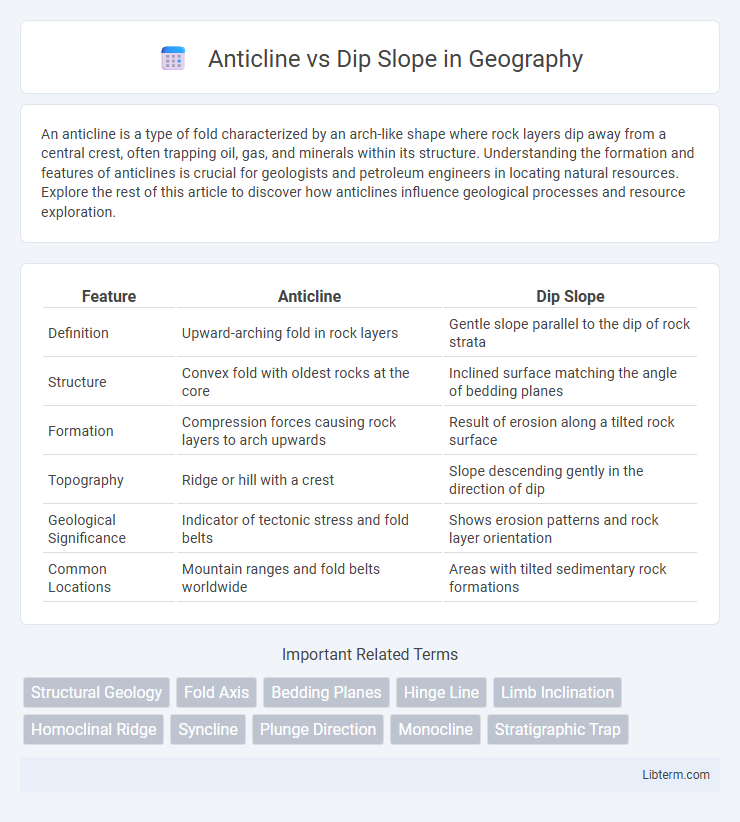An anticline is a type of fold characterized by an arch-like shape where rock layers dip away from a central crest, often trapping oil, gas, and minerals within its structure. Understanding the formation and features of anticlines is crucial for geologists and petroleum engineers in locating natural resources. Explore the rest of this article to discover how anticlines influence geological processes and resource exploration.
Table of Comparison
| Feature | Anticline | Dip Slope |
|---|---|---|
| Definition | Upward-arching fold in rock layers | Gentle slope parallel to the dip of rock strata |
| Structure | Convex fold with oldest rocks at the core | Inclined surface matching the angle of bedding planes |
| Formation | Compression forces causing rock layers to arch upwards | Result of erosion along a tilted rock surface |
| Topography | Ridge or hill with a crest | Slope descending gently in the direction of dip |
| Geological Significance | Indicator of tectonic stress and fold belts | Shows erosion patterns and rock layer orientation |
| Common Locations | Mountain ranges and fold belts worldwide | Areas with tilted sedimentary rock formations |
Introduction to Anticline and Dip Slope
An anticline is a type of fold characterized by an arch-like shape where rock layers bend upward, with the oldest rocks at the core and younger layers dipping away from the center. A dip slope is a geological feature formed on the flank of an anticline or other folded structures, where the land surface slopes in the same direction as the rock strata's dip. Understanding the differences between anticlines and dip slopes is essential for geological mapping and identifying potential reservoirs of oil and natural gas.
Geological Formation of Anticlines
Anticlines are upward-arching folds formed by the compressional forces that deform sedimentary rock layers, creating a convex-upward structure. In contrast, dip slopes are gentle, inclined surfaces often representing one flank of a tilted rock layer or an eroded anticline limb. The geological formation of anticlines involves tectonic stress that folds strata, resulting in a crest with the oldest rocks exposed at the core, commonly associated with petroleum traps and structural geology studies.
Geological Formation of Dip Slopes
Dip slopes form on the gently inclined limbs of folded sedimentary rocks, typically associated with monoclines or anticlines where one side tilts smoothly. These slopes develop as resistant rock layers, such as sandstone or limestone, dip uniformly in one direction, creating an asymmetrical landform. The geological formation of dip slopes is driven by differential erosion, where softer underlying strata erode faster, leaving the harder, tilted layers exposed as sloping surfaces.
Structural Differences: Anticline vs Dip Slope
An anticline is a convex-upward fold in rock layers where the oldest strata are at the core, typically forming an arch-like structure due to compressional forces. In contrast, a dip slope is a gentle, inclined surface that follows the angle of rock strata dip, often representing one side of a tilted sedimentary layer without significant folding. Structurally, anticlines exhibit pronounced curvature and thrust faults, whereas dip slopes demonstrate uniform bedding planes with minimal deformation.
Identification and Recognition in the Field
Anticlines are identified in the field by their convex-upward fold structure with the oldest rock layers at the core, typically forming ridge-like features. Dip slopes, on the other hand, are characterized by a gently inclined surface parallel to the dip of resistant strata, often resulting in asymmetrical hill slopes. Recognizing the variation in rock layer orientation and surface morphology helps geologists distinguish anticlines from dip slopes during field mapping.
Geological Significance and Implications
Anticlines are arch-shaped folds in rock layers that indicate compressional tectonic forces and often serve as traps for hydrocarbons, making them critical targets in petroleum geology. Dip slopes, characterized by gentle inclines parallel to the rock strata's bedding plane, reveal structural tilt and erosion patterns vital for understanding sedimentary basin evolution and groundwater flow. Both features provide key insights into the stress regime, stratigraphy, and resource distribution of sedimentary environments.
Anticline and Dip Slope in Landscape Evolution
Anticlines are arch-shaped folds in stratified rocks that significantly influence landscape evolution by dictating erosion patterns and drainage systems. Dip slopes form where the surface follows the inclined limb of a tilted geological formation, often creating gentle slopes that contrast with steeper scarp slopes on the opposite side. The interplay between anticline structures and dip slopes drives differential weathering, shaping ridges and valleys and guiding sediment deposition over geological timescales.
Economic Importance and Resource Potential
Anticlines often serve as critical traps for hydrocarbons, making them prime targets in oil and natural gas exploration due to their arch-like fold that can accumulate significant petroleum reserves. Dip slopes, characterized by gentle inclines along sedimentary layers, influence the stability and accessibility of mineral deposits and groundwater resources, impacting mining operations and water supply management. Understanding the structural differences between anticlines and dip slopes aids geologists in predicting the location of valuable resources, optimizing extraction strategies, and minimizing environmental risks.
Examples from Notable Geological Sites
The Llano Uplift in Texas exemplifies an anticline with its arch-like fold exposing older Precambrian rocks. In contrast, the dip slope of the cuesta formations in the Black Hills of South Dakota demonstrates gentle inclines parallel to tilted sedimentary layers. These geological sites highlight the distinct structural differences between anticlines and dip slopes through visible rock formations and erosion patterns.
Summary: Key Differences Between Anticline and Dip Slope
Anticlines are upward-arching folds in rock layers formed by compressional forces, typically featuring a convex-up shape with the oldest strata at the core, while dip slopes are gently inclined landforms formed by differential erosion along tilted rock layers. Anticlines expose folded rock strata and often serve as traps for hydrocarbons, whereas dip slopes follow the uniform dip of resistant rock beds, influencing landscape drainage and slope stability. The key distinction lies in anticlines being structural geological folds, whereas dip slopes are geomorphological features shaped by erosion on inclined strata.
Anticline Infographic

 libterm.com
libterm.com